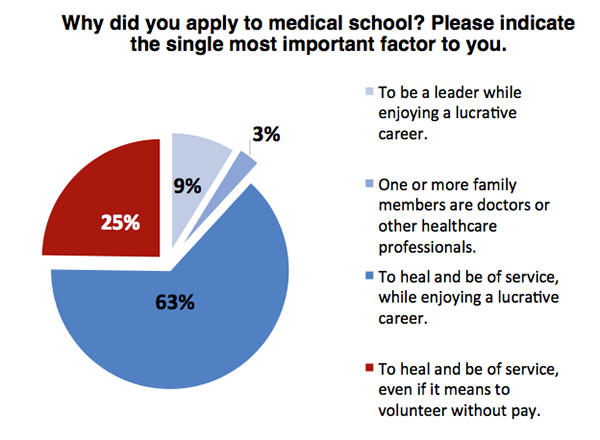
4 Options to view the study results:
Option #1: Full Report (Time to read: 30 minutes)
Includes all data.
Click here to read the full report. (For best viewing experience, click the full screen icon to read the report in full screen mode.)
Option #2: Conference Presentation (Time to watch: 29 minutes)
Live-recorded conference presentation of the results including background, rationale, hypothesis, select results and analysis.
Click here to watch the presentation.
Option #3: Brief Analysis (Time to read: 11 minutes)
Short commentary on the results including background information, rationale, data validation, analysis, and future directions.
Click here to read the brief analysis.
Option #4: Study Highlights (Time to read: 1 min)
- 95% of medical students and residents believe current admissions practices need an overhaul and 94% would support a new, improved and transparent admissions screening tool.
- Majority (75%) of future doctors report they were primarily motivated to apply to medical school by status, financial gain, or familial tradition.
- Only 25% of current student & residents are intrinsically motivated and are willing to pursue medicine without external rewards.
- 30% of medical trainees come from households with an annual income of over $120,000/year at the time of medical school application.
- 54% of overall medical students and residents identify themselves as Caucasian with 39% of those from families earning over $120,000/year, the highest proportion of all groups.
- On the other hand, 61% of those identifying as visible minorities were from families earning less than $80,000/year.
- Use of MCAT preparation and admissions consulting services is not correlated with wealth.
- No notable differences were observed in the reported trends across various admissions tools used to select applicants.
- No correlation was found between cultural background or socioeconomic status and intrinsic motivation to pursue medicine.
- Selecting applicants based on intrinsic motivation reveals a new approach to admissions practices in an effort to reduce socioeconomic and racial bias, while selecting best-suited future medical doctors.
Medical school admissions practices in the U.S. more likely to select applicants motivated by status, financial gains, and familial pressure to pursue medicine and may result in bias against applicants from lower income levels, new SortSmart study suggests.
American medical schools are meticulous in selecting appropriate applicants as future medical doctors. However, the ability of the current medical school admissions process to select well-suited applicants that genuinely want to pursue medicine without external rewards is under question, according to the American medical school admissions study survey by SortSmart Candidate Selection Inc. (“SortSmart”).
“This inability to select applicants based on their intrinsic motivation, has serious consequences because the future of healthcare depends on medical doctors who are internally motivated and find medicine rewarding on its own, rather than those who may be primarily motivated by fortune and fame.” Said Dr. Behrouz Moemeni, PhD, CEO at SortSmart. “If we continue to inadvertently select future medical doctors based on their desire to have a lucrative career and/or enjoy high status in society, we will continue to see a rise in complaints about on-the-job professional misconduct, never mind the disservice to all, including patients and the applicants themselves.”
Concern over American medical school admissions practices: 75% of medical students and residents are motivated by income security, status, and parental pressure to pursue medicine.

Medical schools are tasked with the critical job of selecting applicants that are more likely to both perform well during medical school and later on as medical doctors.
The admissions process has been traditionally focused on admissions test scores and professionalism with limited ability to assess intrinsic motivation, which is defined as the desire to engage in an activity that is self-rewarding on its own regardless of external rewards.
The findings of the SortSmart study reveal that 75% of medical students and residents are attracted to the profession primarily by the pursuit of a lucrative career, status, and/or because one or more family members are medical doctors. Only 25% are intrinsically motivated to pursue medicine indicating that they were pursuing medicine “to heal and be of service, even it means to volunteer without pay.”
Climate of bias: 30% of accepted applicants come from households with income levels in excess of $120,000/year, 69% of whom are Caucasian.

The fairness of admissions practices has come under question over the years with some arguing that admissions practices are skewed in favor of the wealthy while biased against those of visible minority groups and those from lower income levels (for example, see here, here & here).
The survey indicates that 54% of respondents are Caucasians followed by Asians at 18% and other visible minorities at 28%.
A troubling finding by the survey was that 58% of those accepted to medical school came from households making over $80,000/year, with an alarming 30% coming from households with income levels in excess of $120,000/year.

The results further showed that 69% of those from income levels of over $120,000/year identified as Caucasian, while only 31% of Caucasians reported to be from families earning below $80,000/year.
On the other hand, 61% of those identifying as visible minorities were from families earning less than $80,000/year while only 20% reported to belong to the category of high earners with income level of above $120,000/year.
Furthermore, higher household income appears to increase the probability of receiving more than one acceptance. Specifically, the percentage of respondents receiving more than one acceptance increased from 51.7% for those whose families earned less than $80,000/year to 57.4% if their family earned more than $80,000/year.
MCAT and admissions consulting services do not contribute to the observed bias in favor of the wealthy.

While the use of MCAT preparation and admissions consulting services is prevalent amongst applicants, use of such services does not correlated with income levels indicating that these services do not contribute to the observed bias in favor of the wealthy.
Evidence of distrust: 61% of students and residents say all admissions assessment scores must be shared with applicants.

When asked to rank the transparency of current admissions assessment tools, reference letters was chosen as least transparent (24.1%), followed closely by the written applications (23.8%), and the Medical College Admissions Test (MCAT) (20%).
Conversely, when the respondents were asked to indicate which admissions tests are most transparent, 32.5% of respondents chose the MCAT, followed by the traditional/panel interview as the most transparent, indicating a divided opinion about the MCAT amongst future physicians.
Opinion about the situational judgement tests multiple mini interview (MMI) and computer based assessment for sampling personal characteristics (CASPer) depended on familiarity with the tests.
Respondents that took the CASPer ranked it as least transparent, however those that took the MMI ranked it as most transparent.
Notably, 61% said they don’t approve of the common practice of not sharing admissions results with applicants reporting that they believe all admissions assessment scores must be shared with applicants.
Root cause of the problem: 95% believe admissions assessment practices can be improved.
69% of medical students and residents believe that the current admissions practices can be improved and an additional 26% express that there’s room for “major improvement”.
Optimism about the future in the advent of innovation: 94% would support a new screening tool.
94% of future doctors remain optimistic and are willing to embrace a novel screening tool, if it is proven to be fairer and better at selecting future medical doctors.
The observed trends are ubiquitous regardless of the type of admissions screening tool used to select applicants.
The study did not find any notable differences in the reported trends based on the admissions screening tool used to select future doctors.
The silver bullet: selecting for intrinsic motivation can alleviate the bias against those from lower socioeconomic status and visible minorities, while selecting those that are genuinely motivated to pursue medicine to serve others.

No correlation was found between cultural background or socioeconomic status and intrinsic motivation, pointing to a promising new way to select applicants.
“While some of the current medical school admissions tools have been reported to be able to predict future medical trainee examination scores, the findings suggest that they are not able to select applicants based on intrinsic motivation, a predictor of future on-the-job performance. This is not surprising, because the ability to predict future academic or professionalism test scores does not equate with the ability to predict future on-the-job conduct. In other words, it is possible to select applicants that are highly professional on paper and score high on retention of scientific facts, who are not necessarily internally motivated to pursue medicine. This could naturally lead to professional misconduct and attrition. On the other hand, when applicants are intrinsically motivated, they would do everything to learn and improve overtime and less likely to get frustrated easily and display signs of professionalism misconduct under pressure because they find medicine self-rewarding on its own. Importantly, a second consequence of current admissions practices is the apparent bias against those from lower socioeconomic status. These findings highlight the need for adoption of a novel candidate selection tool that reliably measures each applicant’s level of intrinsic motivation, a factor uncorrelated to wealth or cultural background. Such a tool will not only make the selection process more democratic, fair, and equitable but will result in selection of better-suited applicants with implications in university admissions and employee selection in industry.”, said Dr. Moemeni.
Watch SortSmart CEO present the findings at the BSI conference:
If the video does not view on your browser you can watch the video directly on YouTube by clicking here.
Full Report:
Click here to read the full report. (For best viewing experience, click the full screen icon to read the report in full screen mode.)
About the survey:
The SortSmart survey was completed using Qualtrics survey software with a representative sample of 469 American medical school students and residents. A probability sample of the same size would yield a margin of error +/- 5%, 19 times out of 20.
About SortSmart®:
SortSmart Candidate Selection Inc. (“SortSmart”) develops innovative candidate selection solutions and software for university admissions and employee selection with an emphasis on selection based on intrinsic motivation to promote diversity while reducing time and resources required to select the best fit applicants. For more information, including media inquiries, contact us at [email protected]


